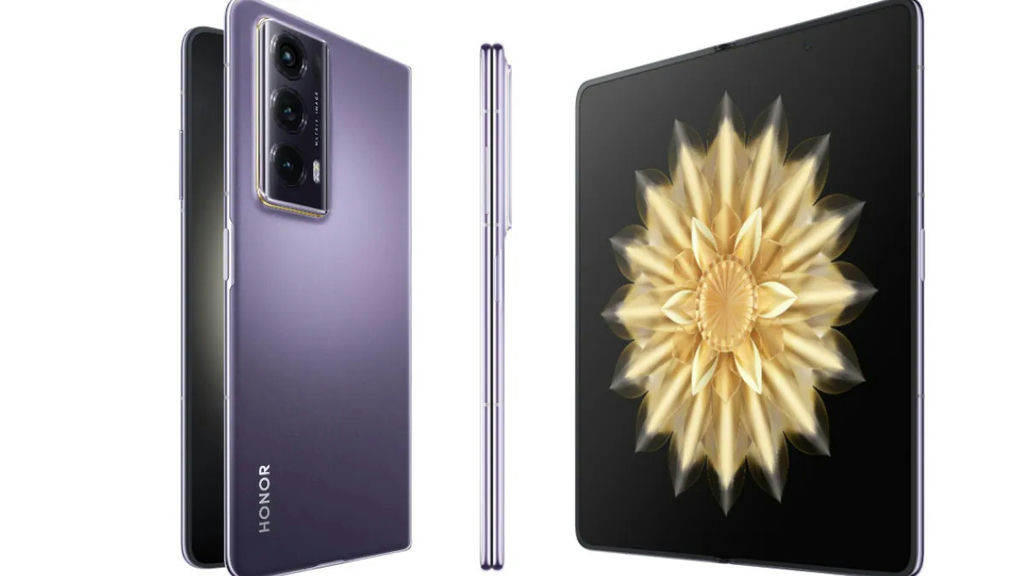
The revolutionary folding smartphone achieves 9.9 mm thickness by leveraging metal PBF for production of the high-precision metal parts
Honor’s new generation flagship folding smartphone Honor Magic V2 was officially released on July 12th and presented by the company’s CEO Zhao Ming. The new model from the Chinese brand redefines folding-screen mobile phones by achieving a closed thickness of 9.9 mm, leading folding-screen mobile phones into the millimeter-level era. This was made possible by the use of metal 3D printing technology from Hanbang Technology (HBD) to produce the Luban titanium hinges.
In addition to its record thinness, the Honor Magic V2 has also achieved multiple “firsts” in the folding screen industry: it is the world’s first folding screen mobile phone that supports zero-risk dimming and eye protection with both internal and external screens, and it is the world’s first folding screen mobile phone. The screen is equipped with the second-generation Snapdragon 8 leading-edge processor, a self-developed radio frequency enhancement chip, and a new generation of Honor Qinghai Lake dual batteries with longer battery life.
In the process of thinning and lightening, the Honor Magic V2 has not lowered its requirements for product sturdiness and durability. In fact, it is the world’s first mobile phone that has passed the Swiss SGS high-reliability folding quality gold standard certification. This means that the titanium 3D printed hinges can withstand 400,000 folding durability tests. Even after 200,000 foldings, the screen crease only changes by 36μm, which is equivalent to a hair. In addition, the external screen of the Honor Magic V2 series is equipped with second-generation nano-ceramic glass, and its drop resistance performance is 30% higher than that of the previous generation of materials.
The thinning and weight reduction of folding screens is a systematic project. The Honor Magic V2 looks to customize the thinness and lightness of each component. In terms of hinge components at the core of the folding screen, the new generation of Luban titanium hinge uses self-developed shield steel material, which can withstand a pressure of up to 1800MPa (MPa) and hardness of 550HV; the shaft cover part of the hinge is the part that adopts the titanium alloy 3D printing process for the first time.
Compared with the aluminum alloy material, the width is thus reduced by 27%, but the strength is increased by 150%, which perfectly balances lightness and reliability. Not only that, in order to ensure that the product is light and thin, the newly customized 0.22 mm ultra-thin heat dissipation VC, Type-C interface module, fingerprint recognition module, etc., further “compress” the internal space from the overall structure.
According to a report from the launch press conference, that appeared on Weixin, because traditional processing of titanium alloy is difficult and the yield rate is low, resulting in high production costs, it has not been widely used in the 3C (computer, communication and consumer electronics) industry. The metal 3D printing process can effectively solve the problem of forming titanium alloy materials.
In addition to the advantages of lightweight and strength improvement brought by the characteristics of titanium alloy materials, combined with metal 3D printing technology, on this basis, the weight of parts can be further reduced through design optimization of lightweight, integrated and thin-walled structures. And improve product integration.
The difficulty of metal 3D printing 3C product metal parts lies in the integration of equipment, materials and technology. According to the fine structure characteristics of 3C product metal parts, Hanbang Technology (HBD) has developed a special ultra-fine printing machine and process, which can realize the minimum part forming accuracy of ±0.025mm and wall thickness of 0.2mm, so as to meet the lightweight and integration of 3C product metal parts and fine structure requirements. Hanbang Technology focuses on the development of metal 3D printing equipment and technology and is committed to helping the upgrade of 3C electronic consumer products with a professional attitude and exquisite craftsmanship and promoting the mass production and application of metal 3D printing technology in the field of electronic consumption.
Subscribe to AM Chronicle Newsletter to stay connected: https://bit.ly/3fBZ1mP
Follow us on LinkedIn: https://bit.ly/3IjhrFq
Visit for more interesting content on additive manufacturing: https://amchronicle.com
Building on their established successes in India and the USA, EOS and Phillips Machine Tools…
CPAC, a subsidiary of SCG, has entered into a significant partnership with SAMSUNG E&A to…
A research team from Graz University of Technology (TU Graz) in Austria has introduced two…
Aircraft maintenance plays a critical role in today's aviation industry, especially given the current challenges…
Calum Stewart Calum Stewart, a leading figure at SPEE3D, has been at the forefront of…
The Vice President of Rolf Mack at KraussMaffei talks about the future vision of Additive…
This website uses cookies.